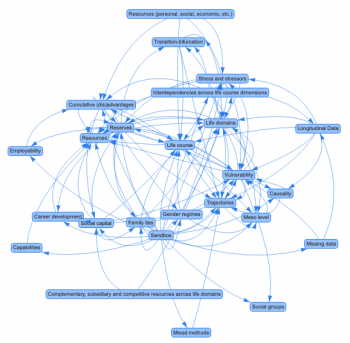Main Page: Difference between revisions
Livesadmin (talk | contribs) No edit summary |
Livesadmin (talk | contribs) No edit summary |
||
| Line 6: | Line 6: | ||
<br /> | <br /> | ||
<br /> | <br /> | ||
Initially reserved to LIVES members only, the wiki glossary is now open to the general public for consultation.<br /> | |||
<br /> | |||
If you wish to add a new definition on the life course and vulnerability, suggestions and contributions are possible by sending us an email to <a href="mailto:lives.scientific@unil.ch>lives.scientific@unil.ch</a> | |||
<br /><br /> | |||
Please, cite [https://apastyle.apa.org/style-grammar-guidelines/references/examples/webpage-website-references in the APA standard] as reference for any use of the wiki-glossary. | Please, cite [https://apastyle.apa.org/style-grammar-guidelines/references/examples/webpage-website-references in the APA standard] as reference for any use of the wiki-glossary. | ||
Revision as of 12:31, 4 October 2021
Welcome to the LIVES wiki-glossary!
This wiki is dedicated to helping researchers in the social sciences, junior or advanced, who need to have an overview of the critical concepts associated with research on vulnerability in a life course perspective. This initiative aims to make interdisciplinary research more straightforward. With over 30 central concepts described and explained, it includes terms such as vulnerability, trajectories, reserves, cumulative (dis)advantages, resilience, longitudinal data (retrospective and prospective) and many more.
It is a project of the Centre LIVES
Initially reserved to LIVES members only, the wiki glossary is now open to the general public for consultation.
If you wish to add a new definition on the life course and vulnerability, suggestions and contributions are possible by sending us an email to <a href="mailto:lives.scientific@unil.ch>lives.scientific@unil.ch</a>
Please, cite in the APA standard as reference for any use of the wiki-glossary.
List of definitions
| Concept | Author(s) | LIVES Glossary visualisation |
|---|---|---|
| Capabilities | Jean-Michel Bonvin | 
|
| Causality | Paulo Ghisletta | |
| Career development | Koorosh Massoudi, Jacques-Antoine Gauthier, Ieva Urbanaviciute | |
| Cumulative (dis)advantages | Marie Beariswyl | |
| Employability | Michele Pellizzari, Daniel Oesch, Rafael Lalive | |
| Family ties | Eric Widmer | |
| Gender regimes | Nicky Le Feuvre | |
| Life course | Laura Bernardi, Dario Spini | |
| Life domains | Laura Bernardi, Danilo Bolano | |
| Interdependencies across life course dimensions | Jacques-Antoine Gauthier, Danilo Bolano | |
| Longitudinal Data | Jean-Marie Le-Goff, Clémentine Rossier, Matthias Studer | |
| Meso level | Mattia Vacchiano, Dario Spini | |
| Missing data | André Berchtold | |
| Mixed methods | Emilie Joly-Burra, Oana Ciobanu, Paolo Ghisletta | |
| Reserves | Marie Beariswyl | |
| Resources - fusionner avec: Resources (personal, social, economic, etc.) | Laura Bernardi, Danilo Bolano, Marie Beariswyl | |
| Social capital | Mattia Vacchiano, Dario Spini, Olga Ganjour, Eric Widmer | |
| Social groups | Christian Staerklé | |
| Trajectories | Jacques-Antoine Gauthier, Jonas Masdonati, Koorosh Massoudi, Shagini Udayar, Ieva Urbanaviciute | |
| Transition-bifurcation | Jean-Marie Le Goff, Alexandra M. Freund | |
| Stress and stressors | Marie Beariswyl | |
| Vulnerability | Dario Spini, Laura Bernardi |